|
11 Dover Street
Canterbury
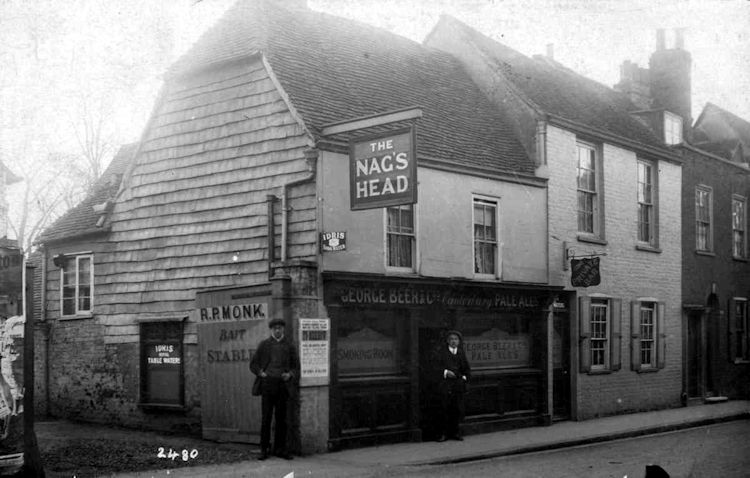
Above photo, circa 1910. |
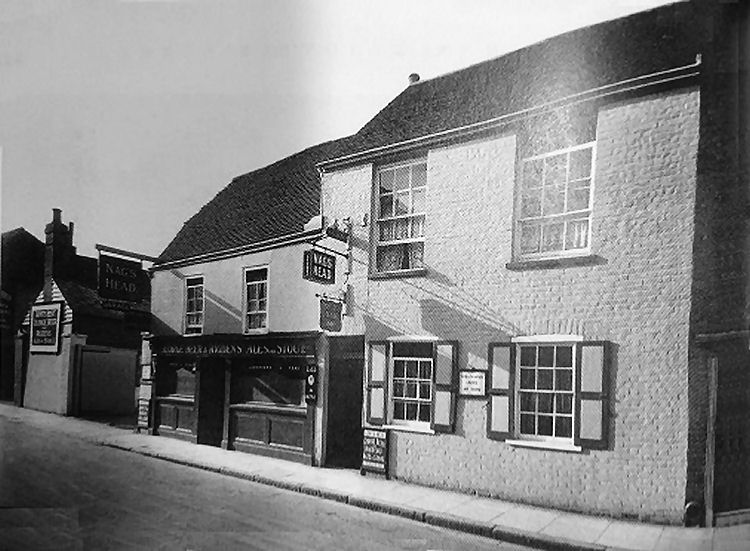 Above picture showing the original "Nag's Head" pre 1930.
|
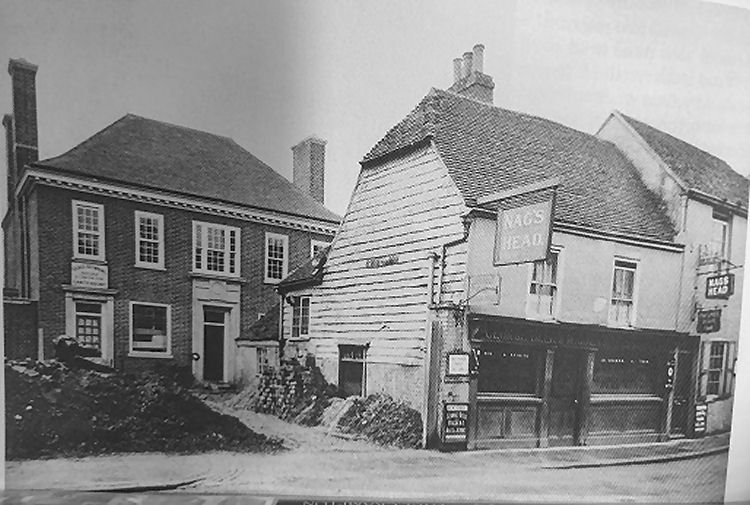
Above photo, circa 1930, kindly sent by Rory Kehoe. |
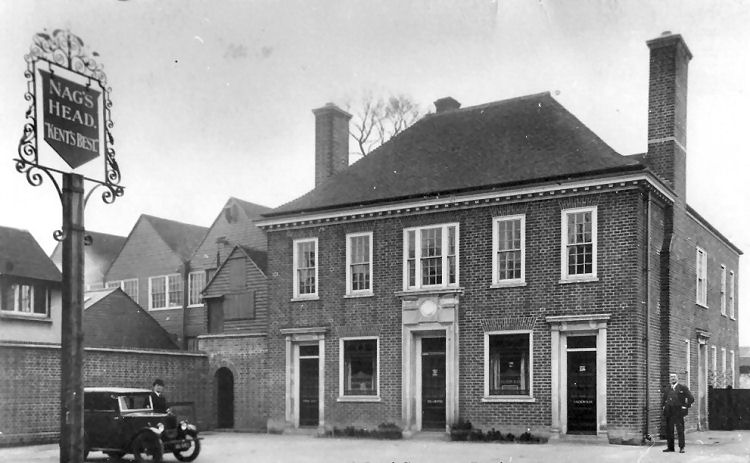
Above photo date circa 1931 kindly sent by Doug Pratt. |
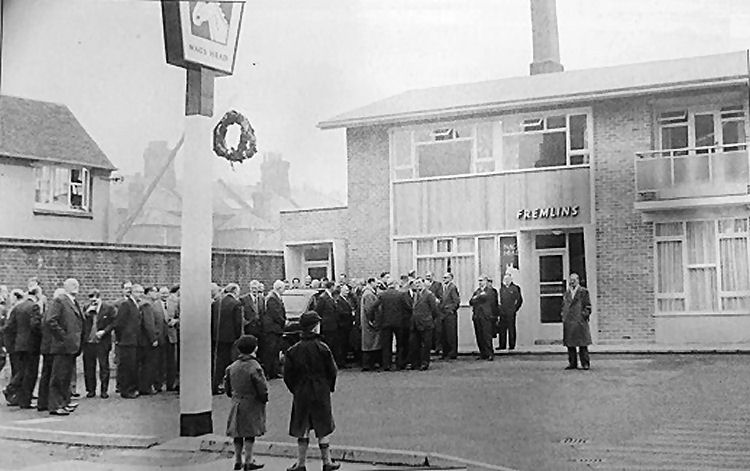
Above photo, 1958, kindly sent by Rory Kehoe. |
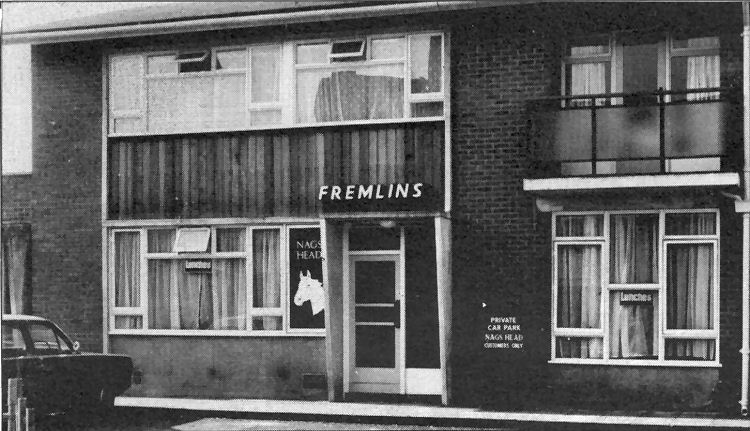
Above picture showing the "Nag's Head" as built and opened on 31st
march 1959.
|
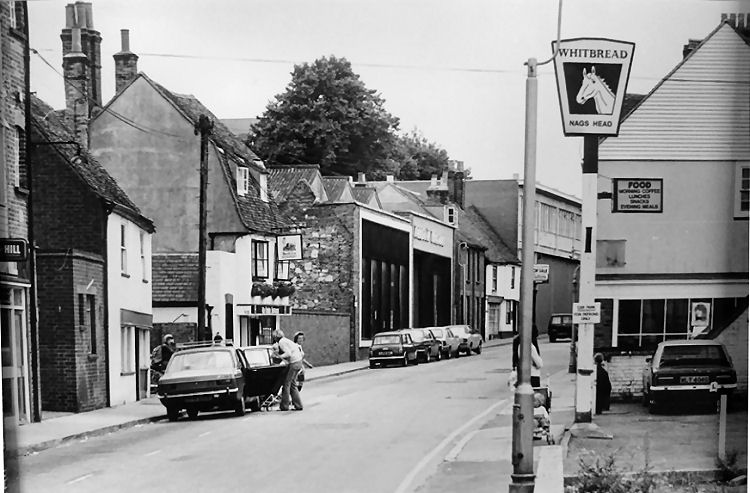
Above photo circa 1974, kindly sent by Rory Kehoe. Also showing the "Beehive"
left. |
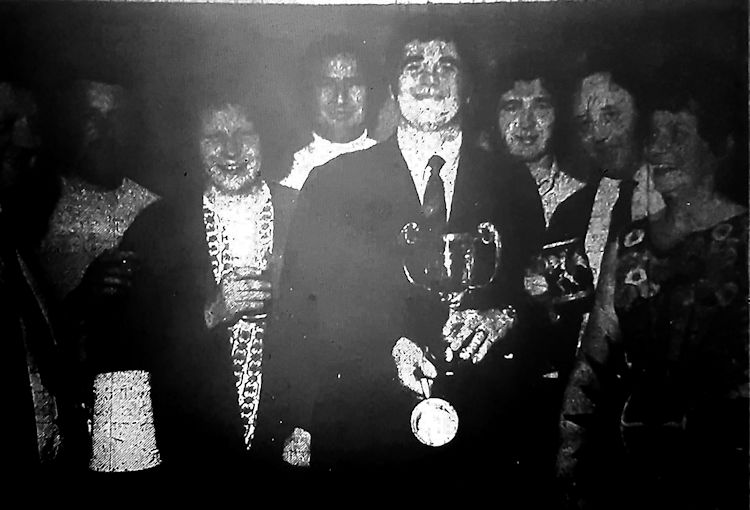
Above photo, date unknown. Caption saying:- "Nag's Head A, Champions of
the Canterbury and District Bar Billiards League (Division 1) for the
third successive year, the trophy from the Sheriff of Canterbury, Cllrs.
Mrs. Rita Kilvert, on Tuesday, At the same time the team presented Mr.
Eddie Hardy, the licensee, and his wife Ann, with a clock in
appreciation of their work. Left to right, Eddie Hardy, Gerry Thompsett,
Brian Gould, Jim Hornibrook, Ted Batchelor (captain) Martin Fowleer, Ron
Patey, Mrs. Hardy. |
The original "Nag's Head" was an 18th century public house that started
life as the "Lilypot" and can be traced back to 1626. By 1858 the premises
had changed name to the "Nag's Head" and was extended to become an inn and
hotel which stood on the pavement of Dover Street. This building was
demolished in 1930 and rebuilt slightly back from the original premises.
This building was destroyed on 31st may 1942 following a bombing raid, but
the pub continued to serve, now as probably one of the smallest inns in
Kent, no larger than 18' by 14' and operating from a pre-fabricated
bungalow.
In 1917 their stabling was being used by C W Hogben, Commercial Motor
Users' Association depot; garage and stabling.
After the war ended the "Nag's head" was again rebuilt as part of a £11
million development plan in Canterbury lasting 20 years. The new building
being opened on 31st March 1959.
The name changed to "Gators" in July 1983.
Further information that has been given me says that the original
building was bombed and flattened during the WW2, and in order that the
licence didn't expire, a temporary prefabracated building was
constructed and used as the "Nag's Head" till at least the early 1950s. When
eventually the building we see was erected on the same site, albeit
containing some superficial additions and external modifications.
The pub was very popular in the 1950s and 60s as it contained a
children's room and catered for families, especially on weekends.
According to Edward Wilmot's book "Inns of Canterbury" published 1988, he
says that the original "Nag's Head" was damaged during WW2 and rebuilt, and
in 1988 was titled "Gators."
Shortly after 1945 the "Nag's head" was described as being:- "Now in
temporary one roomed building."
Latest information says that the premises is currently closed and boarded
up. (October 2012).
|
From the Kentish Gazette, 18 August 1857.
YESTERDAY. [Before the Mayor, Alderman Masters, Wm. Mount, Esq., D.
Matthews, Esq., and Captain Love.]
The Acting Manager of the Theatre applied for a license to keep the
theatre open for performance during the month of August, which was
granted.
Edward Aylett, landlord of the "Nag’s Head," was charged with
cruelly torturing a horse.
Mr. James Yewen, travelling agent to the Animals' Friend Society,
deposed that he saw the defendant at Ten o'clock that morning in
High Street, driving a van in which was the horse now outside the
Court. Seeing the shoulder of the animal bleeding Mr. Yewen followed
the van to the Railway-station, and was there told by defendant that
he was going to drive the horse to Faversham.
Mr. Yewen stated that he had a witness to prove that the horse had
been working for some time with his shoulder in that state, but he
was desired to confine himself to what he had actually seen.
The Bench having looked at the horse, declared it unfit for work,
and told the defendant that he would be subjected to heavy penalties
if he worked the horse again until it was quite well. He was then
fined 2s. 6d. and costs, together 8s. 6d.
According to the Act 12 and 13 Victoriae, cap. 92, any person
cruelly beating or torturing an animal is liable to a fine of £5, or
three months imprisonment with hard labour.
|
|
From the Kentish Gazette, 22 December 1857.
TO INNKEEPERS AND OTHERS.
TO BE SOLD BY AUCTION, BY MR. H. MINTER, on MONDAY, JANUARY 4th,
1858, ON THE PREMISES, AT THE "NAG'S HEAD INN," DOVER LANE,
CANTERBURY.
The property of Mr. Edward Aylett, (who is leaving the Premises),
the whole of the HOUSEH0LD FURNITURE, IMPLEMENTS & FIXTURES IN
TRADE, And Miscellaneous Effects Comprising tent, French, press, and
stump bedsteads with hangings, straw paliasses, bordered and other
mattresses, feather beds, bolsters and pillows, blankets and
counterpanes, wash-stands with ware, chests of drawers, dressing
glasses, bed-room chairs, carpets, and mats, fenders and fire irons,
mahogany, oak, and other dining and tea tables, Windsor, rush seat,
and mahogany chairs, club room furniture, taproom ditto, Bagatelle
Board and other games, quantity of prints and paintings, kitchen
requisites, in copper, iron, and tin goods, earthenware, &c.
THE FIXTURES and IMPLEMENTS of TRADE, Include a bar dresser with
drawers, &c., bar shelves, gas fittings, partitions, two brass beer
engines, complete stone spirit kegs with brass taps, pewter pots and
measures, funnels, tumblers, rummers, ale, wine, and drachm glasses,
beer stillings, and numerous other effects. Also the materials of
lodges, mangers, corn chests, bean mill, measures, forms, pin frame,
&c., &c.
The whole of which will appear in Catalogues, to be had on Saturday
previous to the Sale; at the place of Sale; and at the Auctioneer's,
Graveney Court, Faversham.
The Effects may be viewed on the Morning of Sale, and the Sale will
begin at Eleven o'clock in the Forenoon.
|
|
Kentish Gazette, Tuesday 29 December 1857.
Mr Edward Aylett, of the "Nag's Head Inn," Dover Lane, beggs
respectfully to inform his friends and the public generally, that he has
taken the "Eagle Tavern," Ivy Lane, Canterbury, to which house he is now
removing, and where he hopes to be favoured with a continuance of public
patronage.
|
|
From the Kentish Chronicle, 7 March, 1863.
CANTERBURY POLICE COURT. OFFENDING PUBLICANS.
On Monday, T. Barton, landlord of the “Brewer’s Delight” was fined 1s.
and expenses for having company drinking in his house at a quarter
before 12 o'clock a.m. on Sunday. There were five persons in the house,
three of whom were from Faversham, and the other two belonging to the
city.
Mr. Hogwood, landlord of the “Old City of Canterbury” public house was
also fined 1s. and costs for having two people drinking in his house at
five minutes before 12 o'clock on Sunday morning. Both offences were
proved by Superintendent Davies; who also reported that, during his tour
of inspection, on Sunday morning, he found people drinking in three
other houses—the “Bridge Inn”, the “Beehive” and the “Nag's Head,” but
as the landlords of those houses were not present the cases were not
gone into.
The Mayor remarked that if the Superintendent had warned some of the
offending landlords to attend, he ought to have warned all, as those who
had not been warned would be put to the expense of summonses.
|
|
Kentish Gazette, 18 July 1854.
MARKET PUBLIC HOUSE. TO LET, with immediate possession.
The "Nag's Head," Dover Lane, close to the Cattle Market,
CANTERBURY. Coming in about £135. Declining business is the reason
far the present party leaving.
Apply to Messrs. Baggs and Dray, Longport, or at the "Nag's Head."
|
|
Whitstable Times and Herne Bay Herald, 31 January 1914.
CARRIERS’ VANS OUTSIDE CANTERBURY PUBLIC HOUSES.
PUBLICAN SUMMONED FOR CAUSING OBSTRUCTION.
At the Canterbury Police Court on Friday, Richard Monk, the licensee of
the "Nag's Head," Dover Street, was summoned for allowing a waggon to
stand in that thoroughfare on January 19th thereby causing an
obstruction.
Defendant, for whom Mr. A. K. Mowll appeared, pleaded not guilty.
P.S. Parker stated that at about 10.45 a.m. on the 19th he was on duty
at the Cattle Market, when he saw a number of vehicles standing outside
the “Nag's Head," in Dover Street, on both sides of the road. He went
and shifted some of the waggons that had got horses in them and he
called the landlord’s attention to the fact that he was causing an
obstruction by having so many outside, and to one waggon in particular
which the defendant stored for another man. It was placed out in the
street and witness said to defendant: "No one has got a horse with this
and you are responsible for this four-wheeled heavy waggon." He replied
"Yes, I know that. I have stood it out here because I have not room in
my yard. I usually stand it in the market.” 'Witness asked him to put it
back in his yard and he said he could not as his yard was full, and he
asked witness to come into the yard and see. Witness went into the yard
and saw that defendant had a number of waggons and carts in the yard,
but it was not packed up, and he thought he had room to put a few more.
He had a horse tied up in the yard as well as some in the stable and in
the cart lodge. Witness again asked him to put the waggon into the yard
and defendant replied: "You go and shift those motors round by the
Butter Market, and then I will have these shifted." Witness told
defendant the cars in the Butter Market had nothing to do with him, and
that he must bring the waggon inside. At 11.55 he again went to
defendant and told him to put the waggon inside and he said: "All
right." Witness told him it had been standing outside for an hour and
ten minutes and that he should have to report him for causing an
obstruction. He replied "Oh, you can do what you like." Witness added
that prior to going to the defendant a motor car turning round from
Bridge Street had had to stop until witness had shifted one of the
waggons outside defendants place.
In reply to the Chief Constable witness said that he had been to other
places in the immediate neighbourhood of the defendant’s house and asked
them to remove vehicles, and they had complied with his request. He had
previously cautioned the defendant.
In reply to Mr. Mowll witness said this previous caution was given on
December 8th. He then complained to defendant about his having so many
of his vehicles outside. He agreed that there were always vehicles
outside the "Nag's Head" on market days. His complaint was about the
four-wheeled waggon which the defendant was storing.
Witness admitted that defendant told him he had stood this particular
waggon out in the street to make room for others in the yard. He should
have complained of the obstruction if this waggon had been inside and
others in its place had been outside. It was his duty to complain as
there was an obstruction.
Mr. Mowll:- You have been a constable for ten years and you know that
there are waggons outside a good many places causing what you call an
obstruction?
Yes, sir.
Have you complained about them?
I have had complaints about them, and have been instructed by the Chief
Constable to caution them.
Witness agreed that on Saturday there were carriers' vans outside both
the "Queen's Head" and the "Saracen's Head." The "Seven Stars" was
another place, and the "Star" stables another. It was correct that the
defendant said he could not possibly get anything else into the yard.
Addressing the Bench Mr. Mowll pointed out that this was not an ordinary
case of obstruction such as they got sometimes, and the facts in that
case were practically not deputed at all. The Police Sergeant had given
his evidence very fairly and well and he had no fault to find with the
way in which he had given his evidence. The position really was this:
"Is what this man (defendant) is doing, and what other licensed
victuallers in the city of Canterbury do on market days, and have done
for a very large number of years, probably from time immemorial, is that
or is that not a reasonable use of the highway?" If it was then there
was no evidence of obstruction, if it was not then of course there was
an obstruction. He was putting this bare statement straight a away so
that the Bench could consider what it was that they had really to
decide. Of course, in one sense, heaps and heaps of things were an
obstruction because they did, in fact obstruct the highway. A flock of
sheep being driven into the market on market days during the time that
they were being driven into the market of course obstructed the highway,
and there were countless instances which he might give where people did
in fact obstruct the highway. Farmers had to go to market and of course
they put up at the nearest place where accommodation could be obtained
for their vehicles. He should prove to the Bench, and he thought to
their perfect satisfaction, that in fact on this particular occasion
there was no room to put any more vehicles into the defendant’s yard, in
fact that if more were put in others could not be got out without
dragging several others out into the street in order to get them out of
the yard, which would cause any amount of trouble, annoyance, and
obstruction. What the Bench had to consider was as to whether it was
reasonable for farmers coming into the city to trade on every market
day—and it had been done to the knowledge of one of his witnesses since
1847 or 1849—to use the highway in the way they were or not. Then again
this obstruction did not last all day and not the same sort of
obstruction as might be caused by a man placing a harrow, or a couple of
trestles and a board to contain goods, outside his shop, and which
remained there permanently all day, and day after day. He submitted that
if, as he was hoping it was not going to be, the Chief Constable desired
really to test the question as to whether these carts, which had been in
the habit of going to these houses on market days, ought to do so, and
were disentitled to go there any further, then it was not reasonable to
bring his client there on a first case. If it was simply a case of the
police saying "we quite understand you must have the carts there, but
cause as little obstruction an you can, then his client was agreed and
he would do his best. But if the point was that these people were not
allowed hereafter, because there was no room in the stable yard, to put
their vehicles outside the house where they liked to go for their
refreshment, then he did suggest that it required very grave
consideration by the Bench before they interfered with a custom which
had been going on for a great many years.
Defendant said he had been the tenant of the "Nag's Head" for four and a
half years. The waggon in question (of which the police complained that
day) was one he had had for sale for a farmer and which he put in the
market on market days. It did not go into the market on the day in
question because he had received word that it was sold. He put it out in
the street to make room for two other traps and therefore was causing
less obstruction then would have been the case had he kept it inside and
stood the other two carts outside. He could not put it in the yard when
the Sergeant requested him to do so, as there was only just room for one
the other carts to get out of the yard as it was.
In reply to the Chief Constable defendant admitted that the wagon in
question was not one which had been brought in by a farmer that day with
a horse attached. It was one he stored at 1s. a week. He agreed that the
Sergeant gave him an hour between his first and second visits, but only
two carts went away during that time, and they went from the front of
the house.
Mr. Mowll:- It is a great convenience to people using your house to
put their horses up at your place?
Yes, sir. It is a great source of income to me in all ways.
Mr. William Russell Philpot, of 10, Guildford Road, a Cooper, said he
had known Dover Street well since 1847, and he had always seen carts
outside the "Nag's head" on market days. In fair week there are a great
many more than at other times.
The Chief Constable:- You have lived in Canterbury all your life?
Pretty well.
And you have seen the traffic passing through the city all that time.
Don't you think it has increased very much?
Very much indeed. You can't get away from that.
John Harris, age 71, of 4, Rose Lane Square, stated that he was born
in Canterbury and as long as he could recollect vehicles and stood
outside the "Nag's Head" on market days.
The Bench retired to consider the case and upon returning the Mayor
said they had given very careful consideration to it's because it was a
very important case really to the trade of Canterbury. The Bench
considered that it was a case in which defendant had no right to stand
the trap out in the street and thereby cause an obstruction. But having
regard to all the circumstances of the case they had decided to dismiss
the summons on payment of the costs, which were 14s. 6d.
|
LICENSEE LIST
AYLETT Edward to Dec/1857


NORMAN John to Mar/1860

HALL George Mar/1860-62+
(age 33 in 1861 ) )
 
KEMP John 1867-74+ (age 33 in 1871 ) )
 
EDWARDS George 1881-82+ (age 46 in 1881 ) )

ROGERS Thomas 1891-1903+
  
MONK Richard Percy 1911-13+
 (age 30 in 1911
(age 30 in 1911 ) )

HOGBEN Charles William 1922+

CLARK John Arthur 1930+

POTTER Ernest H 1938+

RENNELLS Bob 1950s (brother of Albert from the "Unicorn,"
Bekesbourne.)
MILLS Bill & Jessie late 1950s-early 70s
HARDY Eddie & Ann ????
https://pubwiki.co.uk/NagsHead.shtml
 From Melville's Directory 1858 From Melville's Directory 1858
 From the Post Office Directory 1862 From the Post Office Directory 1862
 Greens
Canterbury Directory 1868 Greens
Canterbury Directory 1868
 From the Post Office Directory 1874 From the Post Office Directory 1874
 Census Census
 From the Post Office Directory 1882 From the Post Office Directory 1882
 From the Post Office Directory 1891 From the Post Office Directory 1891
 From the Post Office Directory 1903 From the Post Office Directory 1903
 From the Kelly's Directory 1903 From the Kelly's Directory 1903
 From the Post Office Directory 1913 From the Post Office Directory 1913
 From the Post Office Directory 1922 From the Post Office Directory 1922
 From the Post Office Directory 1930 From the Post Office Directory 1930
 From the Post Office Directory 1938 From the Post Office Directory 1938
 Kentish Gazette Kentish Gazette
|







